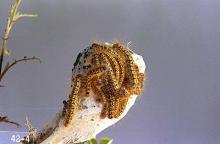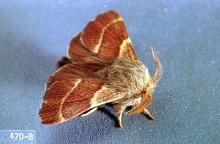Forest caterpillar (Malacosoma disstria)
Western tent caterpillar (Malacosoma californica)
Pest description and crop damage The western tent caterpillar and the forest caterpillar are the main tent caterpillar pests in the PNW. These insects attack a wide variety of plants, including alder, ash, birch, cottonwood, and willow, as well as fruit trees and roses. The adult moths are stout-bodied, light to darker brown, and are active in early to midsummer. They are attracted to lights at night.
Larvae of the forest tent caterpillar are about two inches in length, blue, with black spattered markings as well as white, footprint-shape marks. Larvae of the western tent caterpillar are hairy, dull yellow-brown, with rows of blue and orange spots on the body. Eggs of these moths are laid on twigs or buildings in masses. These masses are brown to gray, about 0.7 inch in length, and look like a brown foam case.
The larvae of both species feed in large groups on foliage of host plants and can cause significant damage by defoliation. Larvae of western tent caterpillars build large silken tents over leaves on which they feed. Larvae of forest tent caterpillars build mats of webbing rather than tents. Larvae can totally defoliate small trees, which may not kill them but reduces growth and makes the trees more susceptible to diseases or harsh weather. Healthy trees usually will grow new leaves by midsummer. Tent caterpillars rarely cause enough damage in commercial pear orchards to warrant treatment.
Biology and life history The moths overwinter as egg masses on twigs or buildings. The eggs hatch in spring as buds break in April or May. The young larvae feed in groups for five to six weeks, growing larger and molting four times. As they mature, they split into smaller groups and move to new feeding sites in the tree. The larvae pupate starting in mid-June, and the adults emerge seven to ten days later. The adults mate, and lay overwintering eggs. There is one generation per year.
Pest monitoring Look for egg masses on twigs or other overwintering sites, and remove them. Masses of young larvae are identified easily in early spring.
Management-biological control
Infestations of tent caterpillars occur cyclically as populations of the caterpillars and their predators rise and fall. Tent caterpillars have many natural enemies. Some birds eat the caterpillars, and small mammals consume the pupae. The larvae of a tachinid fly parasitizes the caterpillars.
Management-cultural control
Home orchardists: Remove egg masses from twigs or other sites. Cut out infested twigs and dip in a bucket of soapy water.
Management-chemical control: HOME USE
Dormant-season spray
- superior-type oil-Some formulations are OMRI-listed for organic use.
Growing-season spray
- azadirachtin (neem oil)-Products containing neem extract may be phytoxic to some pear cultivars. Some formulations are OMRI-listed for organic use.
- Bacillus thuringiensis var. kurstaki-Some formulations are OMRI-listed for organic use.
- bifenthrin-Highly toxic to bees.
- carbaryl-Highly toxic to bees.
- gamma-cyhalothrin-Highly toxic to bees.
- insecticidal soap-Some formulations OMRI-listed for organic use.
- kaolin-Applied as a spray to leaves, stems, and fruit, it acts as a repellant to some insect pests. Some formulations are OMRI-listed for organic use.
- lambda-cyhalothrin-Highly toxic to bees.
- malathion-Highly toxic to bees.
- permethrin-Highly toxic to bees.
- pyrethrins (often as a mix with other ingredients) -Highly toxic to bees. Some formulations are OMRI-listed for organic use.
- spinosad-Some formulations are OMRI-listed for organic use.
- zeta-cypermethrin-Highly toxic to bees.
Management-chemical control: COMMERCIAL USE
Chemical control for tent caterpillar is generally not required in commercial pear orchards.


